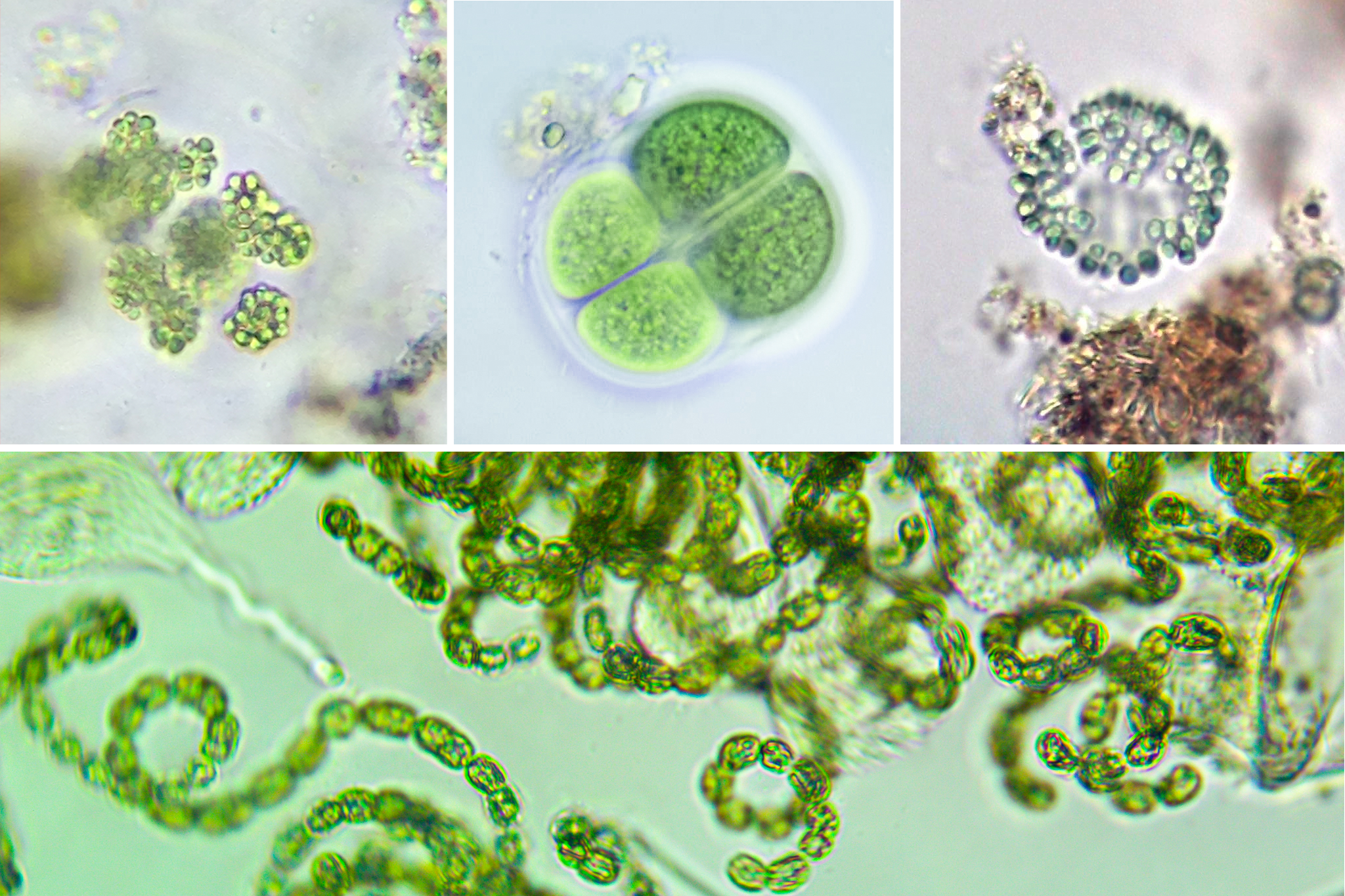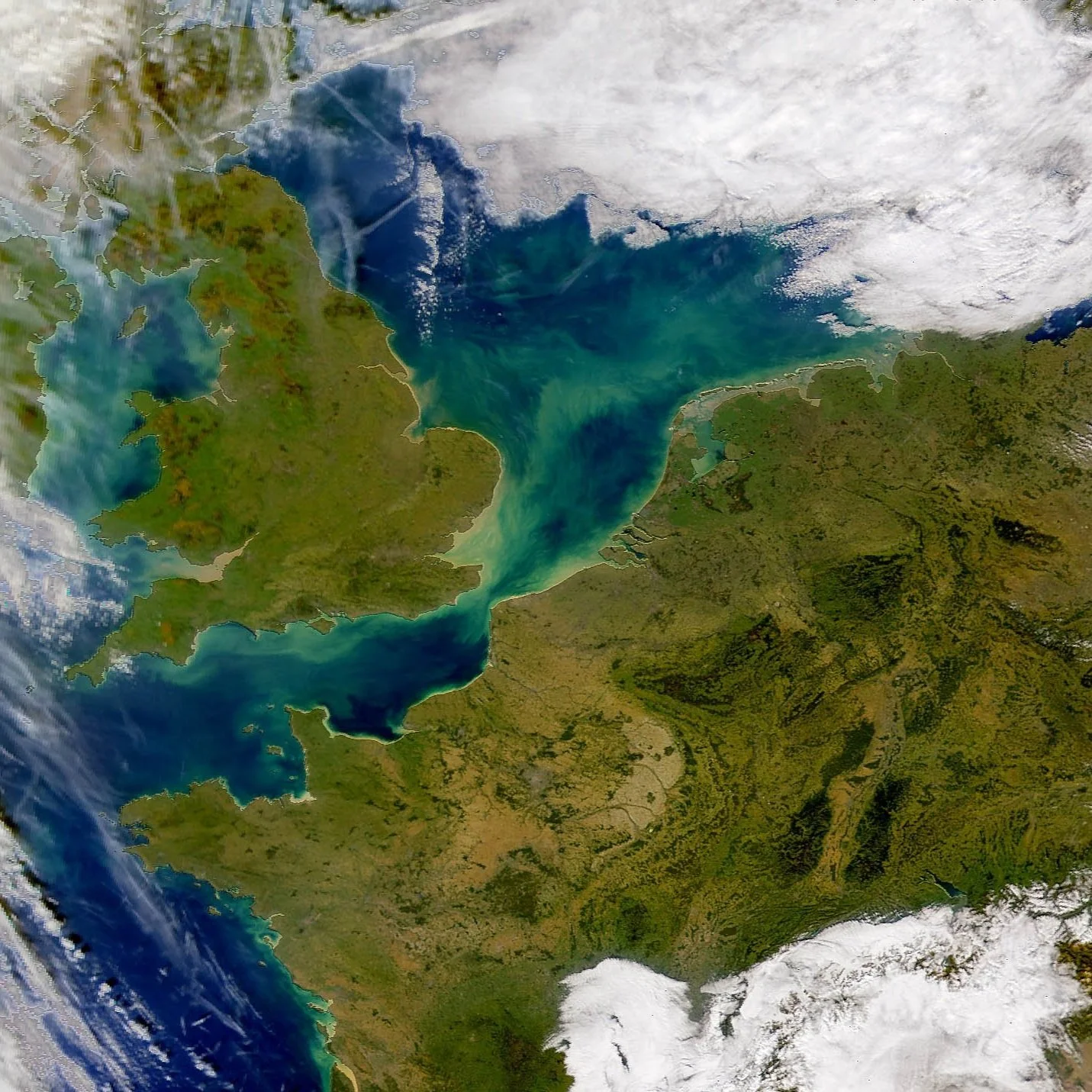Tiny Plankton Could Play Big Role in Monitoring Marine Health
How nano- and picoplankton can further inform marine policy
Image of a harmful algal bloom in Lake Erie on August 14, 2017. Image credit: Aerial Associates Photography, Inc. by Zachary Haslick/ NOAA (CC 0), edits by Rachel Lense for The Science Writer
by Katherine Greene
December 8, 2024
In the face of climate change, Earth’s oceans contend with various problems. As atmospheric carbon dioxide levels increase, the ocean retains more heat, oxygen levels fall, and the water becomes more acidic. These issues can result in negative outcomes, including higher sea levels and a loss of biodiversity. Marine researchers focus on monitoring the relative health of the ocean in response to these changes by tracking the patterns of phytoplankton.
Since 1931, marine researchers with the Continuous Plankton Recorder Survey have monitored phytoplankton to track oceanic changes because of their role in oxygen production and nutrient cycling. Phytoplankton, which are easy to identify with a light microscope, serve as primary bioindicators: plants and animals that are monitored to assess change in an ecosystem. However, a recent study conducted by marine scientists in the UK examined historical data collected from the English Channel to determine whether smaller plankton, called nano- and picoplankton, can serve as reliable marine bioindicators.
Images of various nanoplankton. Clockwise from left to right: Aphanocapsa grevillei, Chroococcus turgidus, Coelosphaerium aeruginem, Dolichospermum. Image credits: Users trientalid, manuel_helsink, mnold1, and sharpthorn on iNaturalist; edits by Rachel Lense for The Science Writer
Plankton, the umbrella term for a wide range of organisms found in the ocean, are classified by their tendency to drift aimlessly through ocean currents. “Although most people think they’re just tiny stuff, they’re quite diverse within themselves,” says Rowena Stern, Ph.D., a molecular ecologist at the Marine Biological Association and the study’s principal investigator. “Their size ranges by nine orders of magnitude. That’s like the width of a needle compared to the length of Great Britain.”
Jellyfish, for instance, are megaplankton. Phytoplankton, the multicellular and photosynthetic surface dwellers that make up the base of many aquatic food webs, are mostly microplankton. Nano- and picoplankton — referred to as “tiny plankton” — are single-celled organisms that have been largely under-utilized by researchers because they are difficult to see using conventional light microscopes — tools that many students learn to use in high school biology classes. Light microscopy can be used to reliably identify organisms as small as 5 microns — about a twentieth of the thickness of a human hair. Nanoplankton range from 2 to 20 microns, so only larger nanoplankton can be seen by a microscope. Picoplankton, which range in size from 0.2 to 2 microns, are virtually impossible to see under a standard light microscope.
However, using a technique called flow cytometry, Stern and her fellow researchers found that tiny plankton account for 99.98% of all plankton in the English Channel and 71% percent of all plankton mass. The group also measured changes in tiny plankton populations using 14 years of data provided by the Plymouth Marine Laboratory Western Channel Observatory. They compared short- and longer-term patterns of tiny plankton to previously described phytoplankton patterns. “We found that the tiny plankton were responding on shorter timescales compared to the larger phytoplankton,” says Stern.
In short, while tiny plankton follow similar patterns to the better-characterized phytoplankton, they respond faster to environmental changes. This is because of their small size: smaller volume and greater surface area than larger plankton aids in faster nutrient diffusion and higher growth rates.
A SeaWiFS satellite image shows the English Channel, where a phytoplankton bloom occurred on October 28, 1997. The mouth of the Thames is filled with suspended sediments. Image credit: SeaWiFS Project/NASA/Goddard Space Flight Center/ORBIMAGE (ESA Standard Licence), edits by Saheel Mehta
Ocean environments are constantly changing, and tiny plankton can offer additional insights into the state of marine health beyond those associated with predictable seasonal changes. An example is the development of algal blooms. “We have now changed the ecosystems in such a way that we’re finding harmful algal blooms of these little tiny plankton in our coastal waters,” says James Sullivan, Ph.D., executive director of the Florida Atlantic University Harbor Branch Oceanographic Institute. As more human-produced nitrogenous waste enters the ocean, tiny plankton species can grow and thrive, outcompeting other species — especially when climate change leads to higher temperatures and nutrient scarcity. The resulting algal blooms produce methane, a greenhouse gas known to contribute to increasing global temperatures. “Understanding these picoplankton and how they might exploit and change the environment is critical,” Sullivan says.
Marine scientists have not historically tracked tiny plankton because of the limitations of light microscopy. However, flow cytometers can autonomously measure individual plankton, regardless of size. In flow cytometry, a solution containing cells — in this case, plankton — flows through a narrow tube past a laser, and a computer analyzes the resulting light scatter and fluorescence. This technology enables marine scientists to measure thousands of plankton per second and provides a more accurate representation of plankton populations, regardless of organism size.
Although flow cytometry has become more readily available in the last 20 years, tiny plankton still aren’t routinely monitored. “Most people like to use the same method year in, year out because they get continuity in the data series,” says Stern. Furthermore, flow cytometry technology continues to evolve, and upgrading equipment can become costly, ranging from $100,000 to $500,000. Comparatively, the light microscope is cheap — one can be purchased for a few hundred dollars — and has remained relatively unchanged since its invention.
As flow cytometry technology matures, scientists should be able to include tiny plankton in their measurements with greater ease. “Understanding the bigger picture of what’s happening in the oceans is not that simple,” says Sullivan. “That being said, anything we can do to understand what’s going on with all the biodiversity in the ocean is critically important.”
Katherine Greene
Katherine Greene has spent the last decade working in diagnostic and research labs and currently works as a necropsy technician in veterinary pathology. She has a bachelor's degree in animal science from the University of California, Davis, and is a student in the Johns Hopkins University M.A. in Science Writing Program. Katherine lives in Sacramento with her three rats, two cats, and dog.
Senior Editor: William Kucinski
Art Editor: Rachel Lense
Copy Editor: Sarah Donahue












